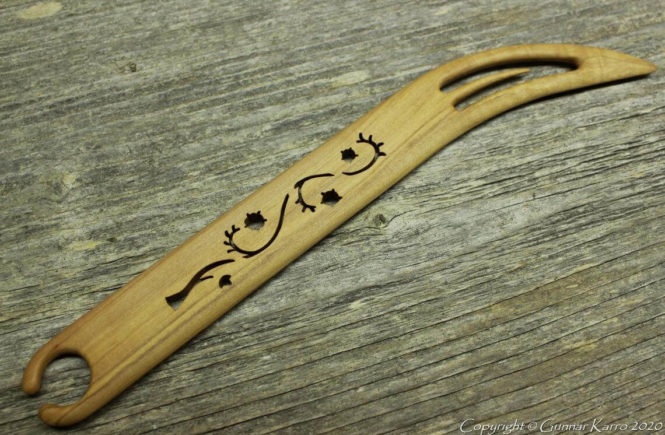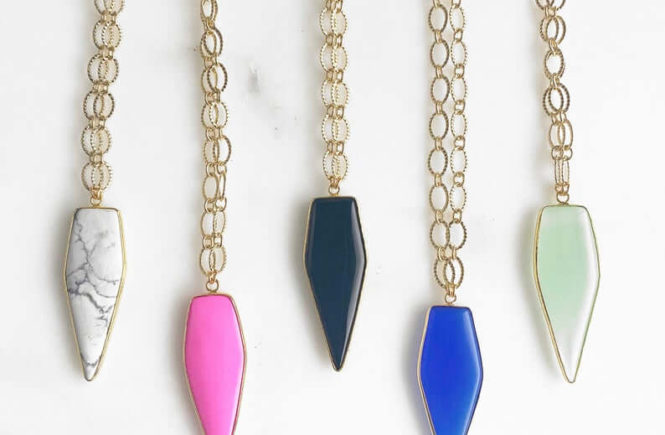[vc_row][vc_column][vc_message]Niche : Home and Living
Shop link : https://www.etsy.com/shop/Ampstrike[/vc_message][/vc_column][/vc_row][vc_row][vc_column][vc_column_text]
Tell us something about yourself, how did you get started, do you consider yourself a crafter,maker,artist…
My shop Ampstrike offers handmade wooden weaving supplies for weavers all over the World. Although I have always been interested in woodworking, my road to creating weaving tools was a rather accidental one, as up to the time I opened my on-line selling for weaving supplies, I was rather making hardwood furniture on order (kitchens, tables, cupboards, etc.). At that time I took part in a workshop for crafters on how to make a business plan, marketing, and so on. Part of that workshop required creating one’s „crafter’s mark“in one’s own favorite technique, which for me of course was woodworking. So I made a small 5×5 cm wooden square in intarsia technique and after I had presented it to other participants of the workshop, I was later approached by a weaver telling me: „You know, if you put holes in each corner, it would make an excellent weaving card“. This little remark opened my eyes to a market of small wooden items vendible by regular mail, and the rest of it is history 😉
I see myself a craftsman chasing after quality and beauty in everything I create from wood – whether it is a small weaving tool or a whole kitchen set. I myself value the quality, durability, functionality, and simple aesthetics of the tools I use for whatever work I am doing, and for the wooden tools I create for weavers to use, I try to create the same set of values. Or as one of my repeated customers once put it: …creating art with tools that have the quality of the art itself is so much more pleasurable… 🙂
How did you discover Etsy? Did you have any previous experience in selling handmade products? Why did you start selling online?
As I was starting selling weaving tools – mainly weaving tablets – I tried selling my items first locally in Estonia. I started in some brick-and-mortar type of shops, with some online selling on the side. In Estonia, our folk costumes have a rich history in using different weaving techniques, both for making fabric itself for a garment, but also for belts, ribbons, and straps as well. Although the skills to weave all these wonderful items have survived through time, we are a small country with only 1.5 million people, and therefore not so many weavers uphold the craft. So it was due to the small market why I turned my eyes to eBay and Etsy and started selling in whole Europe and rest of the world as well.
What products do you sell, what type of materials are used in your creations, how do you design your products, what makes your products stand out ?
I sell mainly handmade wooden weaving tools – tablets, shuttles, heddles, you name it. Also some other fiber-arts related tools – needles, lucets, crochet hooks, as well as some other wooden items – boxes, toys, kitchen utensils, etc. Some of my items are custom made, personalized, some are made to order. I am especially happy if I am approached with a new idea or an item a customer is looking for and in synergy with the client, I can make that wish to materialize. Many of my shuttle and heddle designs have come to life in this way.
What makes my items special is that I make every process along the journey to a finished product all by myself – oftentimes form cutting down a tree to a finished product. In that case, I start with a chainsaw to cut down an old fruit-tree (plum or apple) in the local orchard that is constantly renewing its plantation. Sometimes a storm will make that effort for me – I am constantly on a lookout for trees that can have a second life as an item of use and beauty instead of just becoming firewood. I mill tree trunks into blanks by myself and season them outside for a year or so. Then I move lumber inside to dry it furthermore and only after several years have passed, I will have a first chance to see what I can make out of any given piece of wood.
For the items that are made out of plywood, I glue the thin layers together by myself to ensure the high quality of the material.
[/vc_column_text][/vc_column][/vc_row][vc_row][vc_column width=”1/3″][vc_single_image image=”100001434″ img_size=”737×737″ onclick=”link_image” css_animation=”appear” bb_tab_container=””][/vc_column][vc_column width=”1/3″][vc_single_image image=”100001433″ img_size=”737×737″ onclick=”link_image” css_animation=”appear” bb_tab_container=””][/vc_column][vc_column width=”1/3″][vc_single_image image=”100001432″ img_size=”737×737″ onclick=”link_image” css_animation=”appear” bb_tab_container=””][/vc_column][/vc_row][vc_row][vc_column][vc_column_text]
How was your experience in learning to craft, are you self-taught or did you have a mentor, how long did it take for you to be satisfied with your creations
I have always been interested in woodworking – first in elementary school, in woodworking classes. In later years already at home alongside my father who was an occasional weekend hobby-woodworker. It has always been a hobby of mine, growing from the step at a time, learning new techniques, improving old ones. Making mistakes and learning from them. Over the years my hobby has grown into a full-time job.
What was your original goal when you opened up an Etsy shop? What impacted your decision to start selling online? Do you consider online selling as a side-job, full-time job or extra income to pay for your hobby?
My goal for online selling was simple – to expand further from a small market of Estonia. To make a living out of it if all went well. Selling online differs from selling in physical shops most importantly by the fact that it was and still is cheaper than in shops. This translates into an opportunity to offer a better final price for a customer.
Did you have any fears or reservations before opening up your Etsy shop? Were you worried about profitability or product competitiveness? What are some concerns and questions you had before you got started? How did you overcome them?
I don’t remember having any reservations or concerns what so ever. Setting up a shop was easy and without the real expense, terms for conduct were clear. You just have to put yourself out there and see how it goes.
How long did it take for you to get your first sale? Did you ever thought you would make a lot of sales in the first year? What was a goal you were hoping for? How many sales an average you get per week?
Unfortunately, I cannot recall my first sale on Etsy. I was on eBay before setting up my Etsy shop and for eBay it was with my very first auction – voilà! With starting price of 1 EUR – go figure – I got a sale 🙂
Selling on Etsy differs largely on where you are physically situated in and also on which markets you target.
In the beginning, it might start very slow, gaining feedback and getting sales. Building a client base, getting repeated customers, gaining positive feedback – it all is essential in the long run. And it takes time.
When I started on Etsy 11 years ago and selling now – it differs like a day and night. Etsy has changed tremendously over the decade, some implemented changes have had a positive impact, but there are also those that have really hurt my business model, in which case you have to adapt and make do. Over these years I have had orders coming in daily to down to a couple of orders in total in a month
Do you have a job outside Etsy? If not, are you able to commit full-time to online selling? How does your typical day look like? How do you manage time?
Back when I started with online selling, I used to have a day job. Committing full time to a new thing without a granted monthly profit takes courage. It is good to have a safety net just in case you have no orders – and that situation can happen sooner or later. It took me several years until I found myself confident enough to make it a full-time business.
My typical day depends largely on how many orders I have lined up. It might be working all day long or it might be slow waiting, thinking of new or old items I can make with occasional mailbox checking for new orders.
How does your manufacturing process looks like for e.g. your best selling product? Do you create products ahead of the orders? Do you customize your products, if so how? What are tools that you are using in manufacturing process?
Some materials are similar in texture from piece to piece, like items in oak, ash, and walnut tree – one weaving tablet looks pretty much the same as another. Such items I keep listed and in the item description, I state that there are similar items on sale as well. When an order comes in I will make a required set in requested material.
Other groups of my listings constitute natural wood items that differ widely in appearance dependent on a piece of wood used to make an item – so for these, there is no way of selling them without making an item first. Although it is possible to sell these items as made to order as well, in my experience, a finished item, with a good set of pictures, sells at least 10 times faster than made to order item does.
And then there are custom made items. With those, you have no choice but to show only previously made similar items as an example.
All of my items are handmade using basic woodworking tools – planer, band saw, sanders, drill, and turning lathe. Customizable items are hand cut with a scroll saw. None of my items are made by CNC or laser cut as now so often seen in woodworking section on Etsy.
What is the biggest impact on profitability of your shop? How expensive are the materials you use? How do you price your products?
I base my calculations for item prices mainly on hours spent for making one. Some additional costs come from prices for glue, sanding materials, tools and finishing materials.
What inspires you when you’re creating? How do you get ideas for new products? What are some methods or tools you use to get creative?
Sometimes I get inquiries from customers whether I can make some specific tool or an item I haven´t made before. Sometimes a sample picture for a historic tool is sent as well. I might google it a bit, maybe do a Pinterest search and then I just let the idea to settle, constantly thinking about it – how can I make it, how can I improve it, to make it comfortable to use and durable?. It has to be beautiful and stand the test of time. I am striving for heirloom quality with everything I create. What would be the best construction and so on and so forth… Sometimes it takes days going over and over the details in my mind, searching for the best solution, before I sit down with a pencil and notepad to make the initial drawing.
Do you ship your product internationally? How do you handle postage pricing? What is average time it takes from the order to the delivery? Do you use free shipping? If so, why? How do you package your products?
I do sell internationally. I have shipped my items for every continent save from Antarctica – for some reason penguins do not seem to have interest in my weaving tools so far. Weavers live all over the Word and I am very proud to make tools that are so universal in different cultures.
For shipping, I use our national postal service and send it via registered tracked parcel only. For some countries (depending on local postal service) it gives an opportunity to track the parcel and even if there is no web tracking available for a given country, there is still a chance to look for missing package. Also, if package delivery fails for whatever reason, it will be still returned and I can resend it.
I do not offer free shipping – depending on my location there is no point in it. I charge only for the actual shipping fee. If I hide it in items price and call it „free shipping“, it might give me some extra views as it might be promoted by Etsy due to the general free shipping policy. However, if my item costs 12 USD and I add 9.5 USD on the price for actual shipping costs – it probably will be moved to the last search page anyway due to price and I still have no views.
I package my items in the manner as they are meant for destruction. I use recycled cardboard boxes, newspapers, or any other filling material and lots and lots of tape. And the bigger the package the better it is. I have even sent one wooden needle in a shoebox! Somehow packages smaller in sizes tend to get lost more easily. Deciding on the condition of some packages returned to me, I also believe that some postal service warehouses keep elephants rumbling around their premises, sitting and stepping on the packages, just for the fun of it. So, in conclusion, one can never be too careful if it comes to packaging.
[/vc_column_text][/vc_column][/vc_row][vc_row][vc_column width=”1/3″][vc_single_image image=”100001431″ img_size=”737×737″ onclick=”link_image” css_animation=”appear” bb_tab_container=””][/vc_column][vc_column width=”1/3″][vc_single_image image=”100001430″ img_size=”737×737″ onclick=”link_image” css_animation=”appear” bb_tab_container=””][/vc_column][vc_column width=”1/3″][vc_single_image image=”100001429″ img_size=”737×737″ onclick=”link_image” css_animation=”appear” bb_tab_container=””][/vc_column][/vc_row][vc_row][vc_column][vc_column_text]
Are you worried about competitors? Does it impact your business in any way? If there are a lot of similar products, how do you make your own stand out?
Back when I started offering handmade wooden tablets online more than a decade ago, there was very little competition in the niche. Today the situation is vastly different. Although I do enjoy looking at and marvel on the true craftsmanship on many of the wooden items in different categories on Etsy, the main competition and dumping on prices comes from the shops that list the items as handmade whilst they clearly are not. Indeed, craftsmanship and handicraft have very little to do with the action of taking a cheap piece of building grade plywood and pressing the start button on laser or CNC. Apart from the difference in the time it takes to make one item in this fashion, I can honestly say that the real time-consuming work only starts for me at the time point those items are already out of the machine and ready to sell. As I strive for perfection it takes time to sand and polish by hand every curve and every last hole until the whole item has a silky smooth finish without any sanding marks. Though this is how I stand out and am rewarded with returning happy customers, one simply cannot compete with low pricing from mass production items without sacrificing the quality and actual handcraft.
How do you deal with disputes or bad rating/feedback? How do you manage presale and post sale communication and customer satisfaction?
I have never had any disputes filed on Etsy and my feedback is 100% positive. If you sell items with good quality, you will be rewarded with good feedback.
I always make sure a customer likes what she/he is receiving. Perfect pictures are a good selling factor, but it is not good if pictures are better than the item itself or hiding its details. You cannot hide flaws – you have to highlight those if there are any.
I always message the customer if the order is received and notify them when it will be shipped out. The tracking number is always added on the Etsy order.
If the package is delayed, missing, or lost, I deal with the client by offering a solution – waiting a bit more to see if it turns up, resending a new item, or issuing refund – depending upon a situation.
Also, occasionally I am not afraid to cancel the order and give a refund in the situation where making a custom made item requires input from a client who for whatever reason is not willing to answer any messages and inquiries from my part.
Has selling on Etsy changed your life in any way? If so, how? Did you ever thought you would get this far with your shop? Have you ever been stressed dealing with customers and manufacturing products? How did you deal with that?
Selling on Etsy definitely has had an impact on my life. To have such a large marketplace at my disposal allows me to sell my items all over the World (with exception to those pesky penguins), and every successful sale drives me to do more and more. I have also made acquaintance with many talented weavers worldwide, without Etsy it had never been possible, I think, and I am thankful for the opportunity.
How important is social media for your shop? What are some common tactics you use to promote your products? Do you spend money on ads outside of Etsy? How do you generate excitement/hype around your products?
I have had a Facebook page and I have tried Etsy ads, promoting items and direct email sale coupons. And to be honest, for me, none of them worked. Mabey it is because I don´t have everyday essential items in my shop. I don´t know.
At the moment I have no social media platform or promotion. I have been out there so long that certain weaving groups around the world have knowledge of me and my products. It is just Etsy shop for me and direct advertising from happy customers in their communities 🙂
What are some things you don’t like about Etsy? If you could talk to the CEO of Etsy what recommendations would you tell him to improve sellers and customers satisfaction?
Back when I started selling on Etsy, it was a marketplace for handmade items. Now it is just a large marketplace for everything whether it is handmade or mass-produced.
Making your item to stand out in the category I am selling it is nearly impossible – real handmade items are mixed with semi- or wholly machine-made items. Based just on lovely pictures the customers do not realize the difference between hand-cut or laser-cut and CNC cut items. The advertising all but misleads buyers telling us that:
Laser-cut = handmade
CNC engraving = handmade
CNC routing/milling = handmade
It simply is not. It is just a matter of taking material, putting it under the machine and pushing the button. No more manual work or actual handicraft involved in that process. Fast, simple, effortless, no skill needed.
In this respect, Etsy has lost its starting values and principles as a marketplace for all things handmade.
On plus side Etsy platform is great. Payment system, communication, listing and managing the shop – I love it.
What are some things you did to set your shop for success on Etsy? What is one lesson you learned the hard way?
I have learnt it a hard way that it would be very wise to have an alternative source of income. It can take only one Etsy policy to change and your shop revenue will cease to exist.
For example – the latest Etsy big policy change was that Etsy promotes items with free shipping. For my items, it means that you probably find them on the last search page. Why? Because of a higher price according to their quality and no free shipping. And that’s it. It is all that it takes.
What piece of advice would you give to new or established sellers or those considering to sell on Etsy? How can they avoid beginners mistakes?
It comes down to listings. You need to have lots of those. It is the only thing that will really boost your shop views. List every day if you can – especially if you are starting your shop. Do not list all your items at once. One, two or three a day, constantly over several days or weeks depending of you item count.
Anything you wish to add, feel free to do so here. We value your opinion
Just keep hanging in. You will get sales. You will get great feedback. And you will keep growing.
But keep in mind, although Etsy will keep growing both seller and customer base, making steady income on Etsy will be harder and harder.
I sometimes look at my stats and my nice steady upside slope has turned into downside free-falling with occasional bumps on the road 🙂
You either cope with that or leave Etsy. I am still holding on 🙂 I love what I do, I appreciate that my items are cherished around the globe and I will keep going on as long as I can.
[/vc_column_text][/vc_column][/vc_row]




